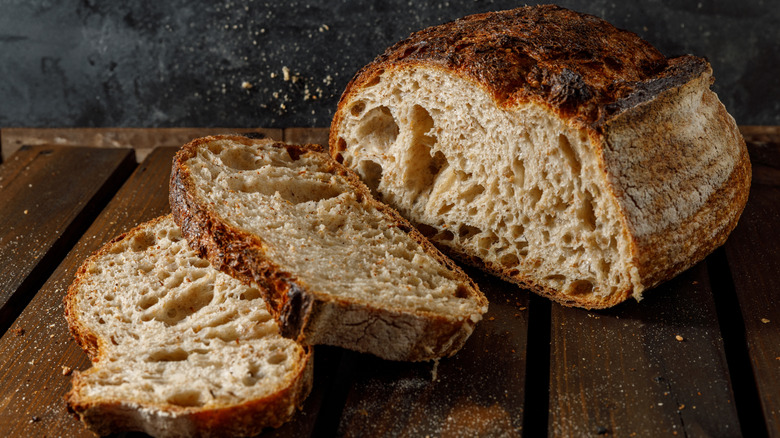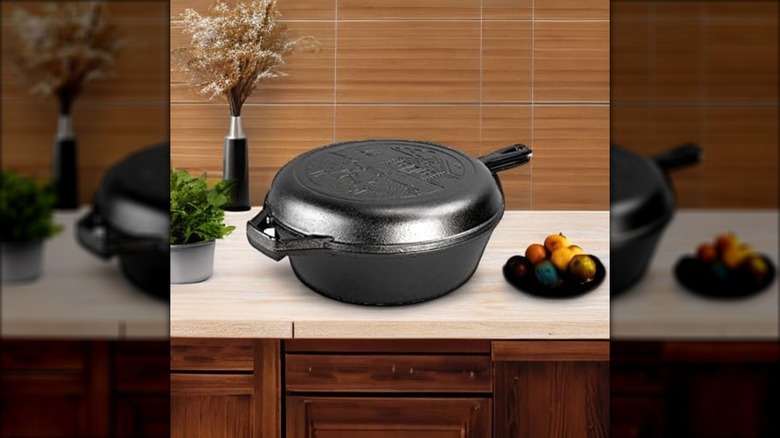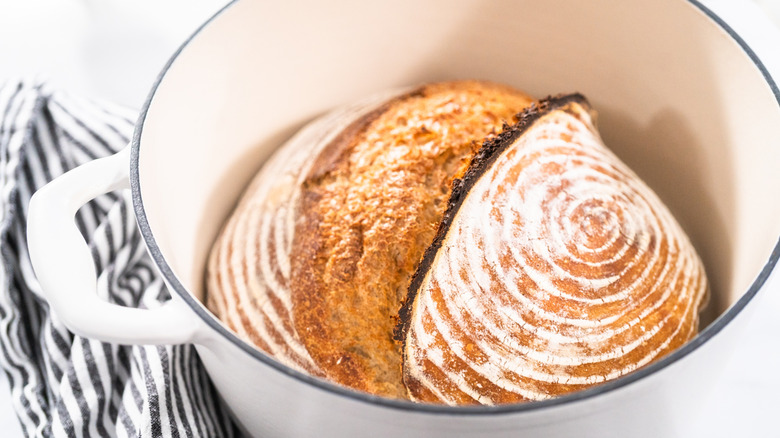How To Bake Sourdough Bread Without A Dutch Oven
We may receive a commission on purchases made from links.
You can bake a nice, plain loaf of basic white bread in a loaf pan, but if you're making sourdough, it seems that all recipes insist on using a Dutch oven (preferably one between five and seven quarts in size). The Dutch oven, a cooking pot that originated in England but takes its name from a similar vessel used in the Netherlands, is preferred for sourdough because it helps the bread maintain an even temperature. As Modernist Cuisine founder Nathan Myhrvold explained, "Cast iron absorbs heat well and retains and radiates it even better, helping to mitigate the temperature drop when you open the oven door." However, he did add that if you don't have a Dutch oven, you can compensate with two other pieces of kitchen equipment.
Myhrvold, who co-authored a cookbook called "Modernist Bread at Home," told us, "A pot or bowl fitted over a baking stone provides a workable solution if you don't have a cast iron vessel." The pot needs to be big enough to fit over the loaf so as to cover it entirely, although a snug fit is preferred to a loose one. If you're making an elongated loaf, Myhrvold suggested using a fish poacher.
A different piece of equipment is preferable to a standard Dutch oven
Even though Nathan Myhrvold extolled the heat-preserving properties of cast iron, he feels that the typical Dutch oven isn't the best piece of equipment for sourdough baking. As he told us, Modernist Cuisine tested a number of cooking pots in addition to Dutch ovens, including Moroccan tagines and ceramic pots designed specifically for bread baking. "While many of the vessels and solutions didn't perform all that well in our tests," he observed, "we found that baking free-form loaves in a 3.2 quart cast-iron combination cooker delivered amazing results. It's our favorite pot by far."
If you're not familiar with this type of pot, Myhrvold explained that it's actually a two-for-one combo: a skillet and pot that fit together so the former forms a lid for the latter. (You can purchase the Lodge cast iron combo cooker from Amazon for $59.99.) When joined, the two pieces of cast iron create the kind of moist, steamy environment that sourdough bread needs to form a crisp, shiny crust. What's more, according to Myhrvold, "The skillet component is key because it's shallow enough that you can gently turn your proofed boule onto it without degassing the dough."
Even if you do have a Dutch oven, you might want to use it a different way
Even though a Dutch oven is standard equipment for most home sourdough bakers, Nathan Myhrvold feels that it's problematic in several ways. "Because of its depth," he said, "you need to take care not to drop the dough into the pot when transferring it, so as not to degas it." He also pointed out that Dutch ovens can be dangerous, saying, "The risk of burning yourself is another reason we prefer the combination cooker to the Dutch oven. The deeper the pot you're transferring your dough to, the greater the chance your hands will make contact with the scorching-hot sides."
If you'd prefer not to purchase a new piece of equipment, there's a trick that will allow your Dutch oven to better simulate a combination cooker. "Try baking the dough on the preheated lid instead of baking the dough in the pot," Myhrvold advised, although he noted that the lid needs to be stable and the handle must fit between the slats of the oven rack. Baking in the lid may reduce the chance of injury because you won't need to place the dough deep inside a blazing hot iron pot.


